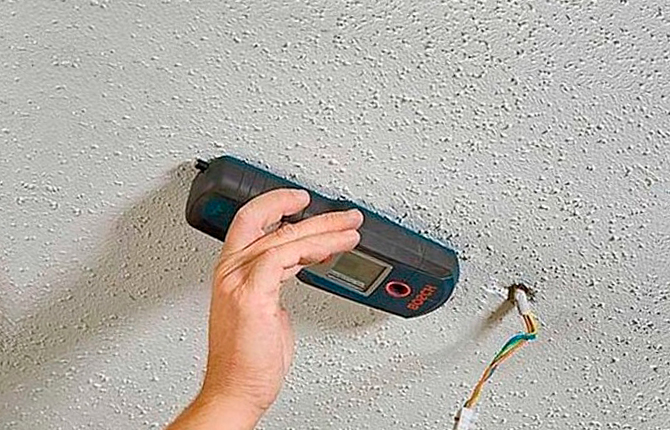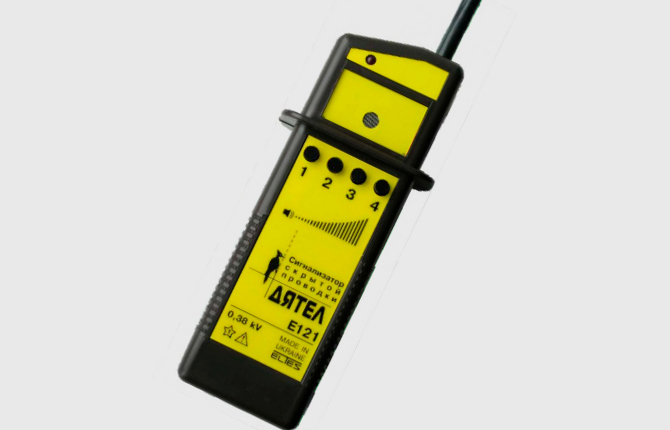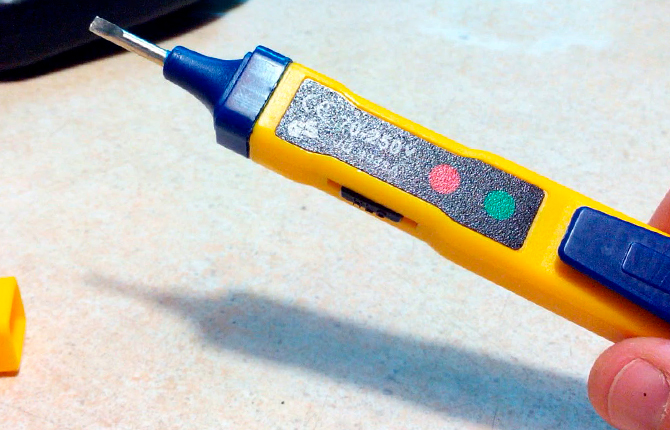Finding hidden wiring in the wall - all available methods
Anyone who has started remodeling their home will face a big problem associated with electrical wiring hidden under a layer of plaster. You can find hidden wiring using different tools. Sometimes completely unsuitable household appliances can help. Of course, many of them will show the location of electrical wires inaccurately, but still this method is simple and does not require large expenses.
The content of the article:
Main types of search
Tools and devices with which you can conduct a search:
- special tools: detectors and locators (cable testers);
- multimeter;
- radio;
- hearing aid;
- indicator screwdriver;
- metal detector.
Using a hidden wiring detector
The operating principle of the hidden wiring detector is based on metal detection technology. The device works almost exactly like a metal detector.
Electrical wires are metal strands made of aluminum or copper. When an electric current passes through them, a magnetic field is formed around them. This is what the detector detects. It reads the field signal and transmits it to the display. And the higher the voltage in the wiring, the brighter the signal.
Varieties of this device:
- Those that detect live wiring only.
- Detect wiring that is without voltage.
- Combined models.
The devices of the last two groups have a magnetic field generator installed. It creates disturbance in the metal.Therefore, these models more accurately determine the location of wires and cables, hence their higher practicality and functionality.
There are a huge number of hidden wiring detectors on the market, which differ from each other in functionality. Some are easy to work with, others will first need to be figured out by reading the instructions from the manufacturer, and then tried in practice.
In the instructions you need to pay attention to the depth of the search. This figure varies in the range of 50-100 mm. At the same time, some models can detect steel reinforcement, wood, and plastic. Each material has its own function.
The work of a search detector is that this device is used to inspect the wall, moving it along the location of the supposed hidden wiring. The maximum beep or indicator on the screen indicates the presence of wires.
Locators differ from detectors in that they search more accurately. This professional device consists of two blocks:
- A detector is also a receiver.
- A generator that emits a high-frequency electromagnetic signal. Masters often call him a transmitter.
The receiver, as a separate element, works like a regular hidden wiring detector, capable of detecting live cables. By connecting a transmitter to it, you get a device with wide functionality. With its help you can detect a broken wire, for which it is valued. The detection depth is up to 2 m, which makes it possible to use the locator to search for wiring in underground installations.
When choosing one or another device, you need to learn how to use it correctly. To do this, it is recommended to try it on open wiring or pipes.This will help you understand what objects he reacts to and how.
In the store, the device must be checked on open wires. For example, put your phone on charge and bring it to its wire. The detector or locator should respond differently depending on the search distance. You can strengthen the testing if you cover the wire from the phone with a plastic object or paper folded in several layers. Cardboard will also work.
The simplest detector for finding hidden wiring is the Dyatel E121 brand. Multifunctional device, lightweight and compact. Monitors not only live wires, but also their breaks. It can also find the neutral or phase wire. This device belongs to the category of electrostatic devices.
There are electromagnetic models on the market that are more effective than electrostatic ones. They also look for hidden live wiring. In this case, the load should not be less than 1 kW. This can be a regular electric kettle.
How to choose the right one
It all depends on what goals are set for the device. If you just need to find hidden wiring, then you shouldn’t buy expensive models. If you need to look for a metal frame or pipes in addition to electrical wires and cables, then it is better to purchase more sensitive devices.
The second selection criterion is the search depth. Many models can detect wiring at a depth of no more than 20 mm. In many buildings the thickness of the plaster layer is 40 mm. That is, such devices will not help here.
The third criterion is signaling. It is usually sound and light. The best option is a device with a display that displays complete information.
Radio search
This home appliance can show where the wires are located in the wall if it is tuned to a frequency of 100 kHz. In this case, the wiring must be live. If you are checking the cable going to the outlet, then you need to connect the load to the outlet - any household appliance, even a low-power one.
The radio receiver must be moved along the wall in the place where the hidden wiring is supposed to be. Noise from the speaker, crackling and other signals that are not typical for work indicate that wires hidden in the thickness of the wall have been found. And the louder the noise, the more precise the installation location. To enhance the search effect, it is recommended to wear headphones.
You need to move the radio along the wall directly along the surface. The tighter the better.
Searching with a hearing aid
Some hearing aid models have a feature called “telephone.” Its task is to enable the hearing impaired to talk on the phone without sound interference.
The hearing aid perceives electromagnetic waves, on the basis of which all telephones operate.
To search for hidden wiring, you need to do everything exactly the same as with a radio receiver:
- connect the wiring to voltage;
- move the device along the wall in search of hidden wires;
- A crackling sound in the earphone confirms the detection of the latter.
Using an indicator screwdriver
You can find hidden wiring in the wall with an indicator screwdriver, but not always. With its help, you can find wires buried under the plaster, located no deeper than 20 mm. This already creates search problems if the cable, for example, is laid in a concrete wall, additionally lined with plasterboard or a thick layer of putty.
Also, the entire surface of the wall can emit radiation. This sometimes happens for unknown reasons. For example, metal inclusions in concrete or other wall material.Even the finishing can be phony: metallic wallpaper, ceramic tiles.
The quality of the search is affected by the sensitivity of the screwdriver. Some models will not respond to anything at all. Therefore, it is recommended to first test the indicator on live wiring.
The process of searching for hidden wiring is carried out as follows:
- Use your fingers to pinch the tip (metal tip) of the screwdriver.
- The opposite indicator side must be applied to the wall and moved across the surface until the light bulb, which is located in the transparent handle of the tool, lights up. This is the location of the live cable.
The method is imprecise, but sometimes it helps if there are no other options.
It’s a different matter if you use contactless screwdrivers for searching, which have a battery in their design. It is this that creates electromagnetic waves that act on metal wiring. In the latter, an electromagnetic field is formed, which fixes the instrument. Either the LED light comes on or the display lights up. In both cases, an audible signal sounds.
The range of action of the screwdriver is small. But with its help you can find wires under plaster or under a not too large layer of cement. The only negative is that the battery weakens quickly, so it has to be changed frequently.
Manufacturers today offer non-contact electronic type indicator screwdrivers. They find cables and wires hidden in the wall and carrying voltages ranging from 12 to 250 volts. At the same time, the tool not only finds them, but also shows what voltage they are currently operating under.
Using a multimeter
The multimeter itself will not detect hidden wiring. It needs an addition in the form of a field-effect transistor VT. You can use one of two brands: KP103 or KP303.What is needed is a field one, because it is controlled by an electromagnetic field. There are bipolar transistors controlled by current. They will not help in finding hidden wiring.
There are three wires sticking out of the transistor, each of which has its own name: drain, source and gate. The multimeter must be connected with its two alligator contacts to the first two wires (drain and source), as shown in the photo below. They are located on the left when looking straight at the transistor from above. It doesn’t matter which crocodile is connected to which wire. That is, polarity does not play a role here.
The third wire, also known as the shutter, remains free. For ease of use, you need to solder a short length of copper wire to it - within 5 cm. This is a kind of antenna that will capture the radiation of the electromagnetic field of hidden wiring.
On multimeter you need to set the operating mode. This resistance is within 200 kOhm. The device, ready for use, must be driven around the area where the electrical wiring is to be laid. When the shutter enters an electromagnetic field, the multimeter will immediately respond and show the maximum set value. The further away from the wiring, the lower the resistance on the screen.
You can use a field-effect transistor without a multimeter. But it will require an ohmmeter, which is connected to the drain, and a power source, for example, a battery, connected to the source. For an accurate search, you can include a speaker in the circuit to notify you that hidden wiring has been detected. Its connection is in series with the transistor.
To increase the search effect, you can change the circuit by inserting not one field-effect transistor into it, but three in series (brand C945). In this case, you can abandon the ohmmeter, leaving only the battery.For the circuit to work, you need to insert one current-limiting resistor into it parallel to the transistors. Its resistance is 1 kOhm.
The antenna connected to the gate should not be a straight wire, but twisted into a spiral. This increases the efficiency of electromagnetic field capture. If you connect an LED light bulb to the sources connected to each other, which is inserted into the resistor circuit, then the detection of hidden wiring can be seen by its glow. The closer to the source of the electromagnetic field, the brighter the light bulb glows.
When creating a circuit, there is no need to connect all the parts to each other through a plateau. This can be clearly seen in the photo below.
We use a metal detector
This device, like a search detector hidden wiring, the most accurate. It's all about the principle of its operation:
- The design of the metal detector contains a coil that, under the influence of an electric current, produces or, in another way, generates electromagnetic waves. They directly act on wiring hidden in the wall.
- Under their influence, eddy currents appear in the wires.
- The latter generate electromagnetic waves, which the metal detector picks up.
There are models that can only find ferrous metal. But even they detect hidden wiring, not to mention those devices that are designed to search for non-ferrous metals.
It must be taken into account that the accuracy of a modern metal detector depends on the power of the coil. Therefore, different models have different errors, which do not exceed 5 cm.
With this device, wires can be found even if they are not live. In essence, a metal detector is the same detector, only inductive.
Non-standard verification methods
There is a lot of freely available information about how you can look for hidden wiring using improvised means that many people have at home. One of them is to use a regular compass.
Compass
The magnetic compass needle will deflect under the influence of the electromagnetic field. But a cable embedded in a concrete wall and under voltage cannot create sufficient strength of this field. That is, its electromagnetic waves are not so strong as to change the position of the arrow.
The same goes for a magnet suspended on a thread. It will not wobble when approaching hidden wires.
Smartphones
Another supposedly non-standard option. Use smartphones that have a special application downloaded. Plus - the phone must have a magnetic sensor. This option does not work even if the wiring is under load.
Still, you should not use household appliances to look for metal in the walls. It is better to buy a detector that has a low price. Simple models do not require special knowledge. The instructions clearly state how and which button to press for the tool to work correctly.
How to find hidden wiring in the wall using a smartphone: video.
If anyone knows other ways to find hidden wiring, please share in the comments. Save the material in your bookmarks so as not to lose effective search methods.









I read the article. Let me think, I’ll try to check how the compass will react to a live wire. It’s good that I had one of these lying around from my last trip. I simply plugged the electric kettle into the socket, attached a compass to its wire and turned on the household appliance, since it has a power of 1.2 kW. As stated in the article, the compass needle did not even move.
You can find any metal object with a metal detector. It’s not for nothing that this device is called that. But how can he distinguish a wire from fittings or a steel pipe, which are also often embedded in walls?